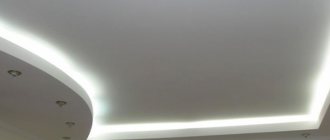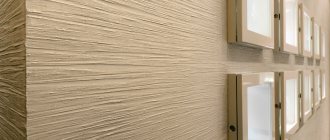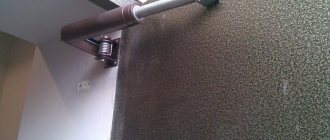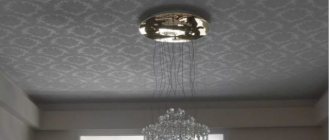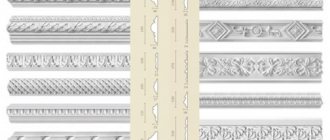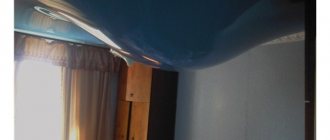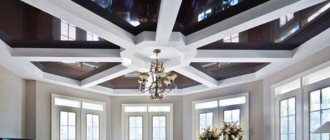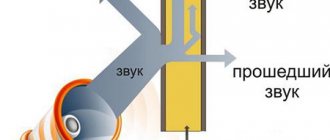Peculiarities
Installing a stretch ceiling is not an easy task and requires craftsmen to have a whole arsenal of tools and devices in stock. Along with a tape measure, a laser level and a hammer drill, the master’s kit uses special mounting spatulas for suspended ceilings. The main purpose of such a spatula is to make threading the ceiling covering fabric into a baguette a less labor-intensive process. The baguette is a special profile strip into the cavity of which the canvas is mounted.
A spatula for suspended ceilings in any design has a handle and a metal tip. The shape of the handle and its material may vary. The tip, in its configuration, also has a variety of shapes to perform all kinds of work. The thickness of the working part of the ceiling trowel exceeds the value of the construction option and ranges from 0.6 to 1 mm.
In addition, the tip of such a spatula is made of high-strength stainless steel. These features do not allow the spatula to bend, which is a necessary characteristic. During operation, the spatula experiences a colossal load from the blade pressing on it.
When stretching one web, several such tools can be used at once, depending on their purpose.
The following types of instruments can be distinguished:
- With a straight nozzle. This species exactly replicates its small-sized construction counterpart. This spatula is convenient for tucking the fabric into narrow, hard-to-reach places. To make work easier, they have a small wooden handle, and the width of their working part is 15-50 mm. A spatula with a straight nozzle will be especially indispensable in those areas of the ceiling that are adjacent to gas or water pipes.
- Curved, straight shape. They perform the main part of the operation of filling the ceiling material into the baguette. Curved spatulas have different angles of the metal part and handle lengths. The shape of their metal part is made in the form of a trapezoid, expanding at the end. Its bend has a different slope and depends on the shape of the profile of the baguette itself.
Curved spatulas are:
- Large with a shoulder blade curved at an angle of 45 degrees . This spatula model is the most popular and is suitable for any installation work with both fabric and polyvinyl chloride material. These spatulas are equipped with a wooden handle 40 centimeters long.
- Small with a blade bent at an angle of 45 degrees. They have the same shape, but differ in a smaller work surface and holder, which makes it easier to work in hard-to-reach areas. The handle of such spatulas is only 10-20 centimeters long.
- An intermediate version of these types of spatulas are medium-sized tools. In addition to a 45-degree bend, spatulas can have the shape of an inclination of the metal part at 90 degrees. With a product of this shape, it is convenient to tuck the canvas into the baguette in its upper part. In addition, with its help it is easy to cope with the installation work of built-in lamps and ceiling fillets.
- Curved, triangular in shape. They are classified according to the same principle as straight lines. May vary in width, angle of inclination and length of the handle. The shoulder blades are triangular in shape with a narrow tip. This type of ceiling spatula is not aimed at the main process of stretching the ceiling, but at leveling it in hard-to-reach areas of the baguette. In addition, it does an excellent job of tensioning the ceiling in curved areas.
- Curved goose spatula. Its geometric shape has a double bend, which is how it got its name - goose. This shape is inherent in both large and small models of this instrument, and the configuration of the blade shape does not matter. This geometric shape of the spatula is used in any of its types. This model is designed for filling polyvinyl chloride material using the harpoon stretching method, while the shape of the baguette profile can be different. At first glance, it may seem that the shape of this spatula is too complex and therefore may be vulnerable during use, but this is not the case. The metal blade of spatulas of this type is made of high-alloy stainless steel alloys, which gives it high strength characteristics as well as resistance to external pressures.
- Angular shape. This type of spatula is designed to fix the ceiling sheet at the four corners of the room. To cope with this task, it is designed with a rectangular or sharp blade, which can also be curved at different angles. This type of spatula has become widespread in the installation of stretch ceilings in open-type profiles (baguettes).
- Semicircular shape. This model has a thin edge of the working part, which is convenient when installing fabric sheets. Thanks to their unique semicircular shape, it is convenient for them to stuff material into a baguette and make unique inserts, while the speed of work will be very high.
- Electric models should be highlighted as a separate type of spatulas for suspended ceilings . This category is an electrical appliance with automatic reciprocating movement of the working surface (blade). This tool can make the work of fixing the canvas easier and can handle its tension in a matter of minutes.
List of tools
Rangefinder
A rangefinder (laser tape measure) is used when measuring a room to accurately determine the length, width, height of a room and its diagonals. This is very important when installing film coatings. Using a rangefinder, all measurements are taken from one point in the room, which is especially valuable for large rooms. The device calculates area and volume.
The most popular models:
- Skil Xact 0530 AA, manufactured in China, allows you to take measurements at a distance of up to 20 m with an accuracy of 3 mm and perform the necessary calculations (area, volume and perimeter of the room). The disadvantages include a dark display and a high price.
- Makita LD060 P, made in China. It is a similar model with a backlit screen.
- RGK DL50 operates at a distance of up to 50 m, measurement accuracy is 2 mm. The model is equipped with a protractor, which allows you to determine the slope of the surface.
- The RZ40 operates at a range of up to 40m, stores up to 1000 readings and displays the last 4 measurements. It is a fairly budget option.
Roulette
A simple tape measure is convenient for measuring curved surfaces and small segments (up to 15 cm), since the rangefinder is not designed for such small distances. The main requirement for the tool: flexible and unbreakable tape. High-quality and durable tape measures are produced by Kraftool (Germany). It is advisable to have a tool with hitchhiking.
Ladder
To work in rooms up to 3 meters high, a stepladder of 5-6 steps will be sufficient. Models with hooks for a hammer drill and trays for small tools and parts are convenient. The most reliable and durable stepladders are those from Alumet (Russia) and Hailo (Germany).
READ MORE: Decorating an arch with decorative stone 51 photos decorating a hallway in an apartment how to decorate interior openings with decorative bricks with your own hands how to paste decorative tiles examples in the interior
Some experts prefer construction stilts instead of folding ladders. They do not require constant lowering and lifting and allow you to quickly install a frame made of profiles or masking tape. The ability to use this device increases the safety of the master: you can perform work in an inclined position without the threat of falling.
Laser level
The laser level allows you to accurately mark the walls before installing the frame for the suspended ceiling. Depending on the operating methods, devices of various modifications are produced.
Using a manual level requires two people. One person holds the device, the second makes the necessary marks on the beam. The wall level is hung on a vertical surface. You can use the device with a magnetic stand and attach it to a metal pipe. The most convenient option is a telescopic spacer rod-tripod. If the level is equipped with a microlift, it can move vertically.
A high-quality device is the Bosh PLL 360. Rotating the beam 360 degrees allows you to mark all points in the room at once.
The laser level can be replaced with a hydraulic level. The advantages of the device include ease of use and affordable price. Domestic models ROS Standard, Master and KEDR are equipped with a hose length from 5 m to 25.
Chop cord
A chop cord (chokline) is required to mark the line along which the profiles are attached. It is a box of paint, inside of which there is a thin cord. When the thread touches the wall, it leaves a straight line on it.
Instead of a store-bought one, you can use a regular cord rubbed with colored chalk, activated carbon or bluing tablets.
Hammer
A puncher for suspended ceilings is used at the stage of installing a frame made of profiles. The tool is a powerful drill that works like a chipper. When installing a lighting system, it is used to attach the mountings for the chandelier and lamps to the base ceiling. The process of attaching profiles requires drilling a lot of holes, so it is recommended to use a good quality hammer drill.
The most popular are 4 models that have almost the same power, rotation speed, number and force of blows:
- Makita HR2450 copes with any walls and is lightweight (about 1.5 kg). The downside is the need to replace carbon brushes every 5-6 months.
- The Bosch 2-26 does not have this drawback and is equipped with a chuck for conventional drills or bits.
- DeWalt D 25123 K does not overheat during drilling.
- Hitachi DH24PC3 is characterized by high-quality work combined with the most affordable price.
Using a drill, holes are made in plastic or metal profiles. The use of power tools makes the work highly productive. The downside is the burrs that remain after drilling.
Reliable and inexpensive models include the domestically produced drill Interskol DU-13/580ER with adjustable speed and change of direction of rotation. For drilling holes in the profile, such a tool is quite sufficient.
For small amounts of work, instead of a drill, you can buy a manual hole punch for metal. With its help, smooth, burr-free holes with a diameter of 6 mm are punched; the thickness of the material can reach 3 mm.
Screwdriver
Designed for fastening plastic or metal profiles, mountings for light sources and other operations using self-tapping screws. Installation of ceiling coverings involves a large amount of fastening work. This requires a reliable screwdriver; a cordless version is desirable. The job will be done faster and you won't have to switch wires.
There are positive reviews about Makita screwdrivers; they are lightweight and equipped with a work area illumination system. The power of the device when installing suspended ceilings is not a dominant factor.
If you perform a small amount of work (in your apartment), you can use a screwdriver instead of a screwdriver.
Hammer
This tool may be needed to hammer in plastic dowels for attaching profiles or embeds. For example, a good hammer from Matrix, it is equipped with a handle made of rubberized material, the weight is small - up to 400 g. But any other one will do.
Hacksaw
A hacksaw is required for cutting metal and PVC profiles when joining in the corners of the room. Also necessary for sawing aluminum baguettes when mounted on an uneven surface. A regular hacksaw for metal is suitable for this. A good option is Stayer and Kraftool - lightweight, durable, very reliable and inexpensive tools.
For large volumes, for example, when installing multi-level stretch ceilings, it is better to use a grinder with a disk for cutting aluminum. But this option is noisier and creates a lot of chips. Additionally, you may need metal scissors and pliers.
File
To process the sections obtained by sawing the profile, you should use a flat file. It is better to choose a model with a sharper notch, designed for working with aluminum.
Mounting blades
Mounting spatulas (spatulas) are designed for filling the canvas into a baguette. They are selected depending on the material of the stretch ceiling.
For PVC coatings with harpoon fastening, several types of spatulas are available; it is enough to have three:
- Straight, 10 cm wide for working in open areas.
- Curved, 5 cm - convenient for performing operations in hard-to-reach places.
- Corner (triangular) for tucking the fabric in the corners.
For installation of fabric stretch ceilings, a rounded spatula is used. It is better to use a plastic spatula to insert decorative tape so as not to damage the material.
READ MORE: Hot glue, what is it, how to use it, how can you make the composition at home, how to use glue, what to replace it with
When choosing a metal spatula, it is preferable to a stainless steel model - rust does not form on them. It is recommended to round off sharp corners with a file; this will protect the blade from damage. Spatulas with a wooden handle are more convenient to use, but those with a plastic handle are lighter. Craftsmen often replace factory blades with homemade ones, with which they are more comfortable working.
Heat gun
A heat gun is the main equipment for installing film stretch ceilings. With its help, the room is heated to 45°C, and the canvas - to 60-70°C. As a result, the PVC film becomes more elastic and stretches easily.
Diesel, electric and gas guns are produced. In residential premises, as a rule, the latter type is used. For an area of up to 20 m², a unit with a power of 15 kW is suitable, for 20-25 m² - 30 kW, over 25 m² - 45 kW.
The gas gun evenly heats the canvas over the entire area at once, its efficiency is almost 100%. American models Master and Remington, Fubag (Germany) and ProfTeplo (Russia) are characterized positively.
The smooth operation of a heat gun depends on the quality of the gas cylinder. You should choose safe composite models; they are lightweight and do not explode, unlike metal ones. An average volume of 22 liters (18 liters of gas) is enough to install 150 m² of ceiling.
Construction hair dryer
A construction hair dryer is used when installing fabric coverings if folds form while stretching the fabric. This is a hand-held tool for local use, which is much smaller in size and power compared to a heat gun and runs on mains power. The hair dryer is equipped with a set of attachments that change the blowing area from 5 to 25 cm². A useful feature is the ability to regulate the temperature of the supplied air.
Particularly popular models:
- Bosch Professional GHO 660 LCD (Germany);
- Makita HG5012K (Japan);
- WELDY ENERGY HT1600 (China).
Painting knife
A painting knife with replaceable blades is used to remove excess fabric when installing using a bead or clip method. Also necessary for cutting holes for spotlights.
The highest quality knife is from the Japanese company Olfa; it has a comfortable handle and reliable design. The blade is very sharp, durable and does not wobble, making it easy to make precise cuts.
Special scissors are needed to cut off the masking tape when joining corners. The design of the tool is equipped with a protractor with notches. This allows you to make a precise cut at a given angle. The top blade is removable, which is very convenient for sharpening. The tool is universal, allows you to cut any plastic, including PVC profiles. A good option is the Stayer 23373-1 model (Germany).
Making a spatula with your own hands for suspended ceilings - useful tips
A common situation: it seems like everything has been prepared for the installation of ceilings, but suddenly it turns out that in fact the most necessary equipment is missing. But don’t worry: we will give important advice and support them with useful photos so that at the most crucial moment you can make a spatula for suspended ceilings with your own hands.
This is what the most common homemade spatula for PVC ceilings looks like.
Most often, it is used after direct tensioning of the canvas - for its correct and safe filling into the appropriate baguette (read about what a baguette is in suspended ceilings).
It can be straight, curved, or angular - and each case has its own specific use. One configuration or another should be selected based on the range of expected work.
Start small - choose a suitable hard scraper with a sufficiently elastic response to any action.
The recommended width of the primary instrument is no more than 3 cm.
An important step is to round the edges and corners of your original tool after metal finishing. Heat the metal thoroughly and bend it enough so that you can comfortably cling to the baguette.
Depending on what level of canvas you need to insert into the baguette - transitional or upper - the spatulas are bent at one angle or another. This is best illustrated by the following photo.
It seems important that the resulting tool for suspended ceilings is not heavy and fits well in the hand. In this case, even the most tedious and tedious work can be a joy.
As you can see, making a spatula with your own hands for suspended ceilings is a couple of simple steps that even the laziest owner can master. You're not one of those, are you?
Tips for choosing a blade for installing suspended ceilings (video)
Installing a stretch ceiling is a specific task that requires the use of professional tools, including the so-called mounting spatulas for inserting films and fabrics into the grooves of the baguettes.
Principles of fixing the canvas using blades
When the profile frame is installed, the tension fabric is suspended using crabs in the corners of the room. After this, it’s time to use blades to install suspended ceilings. With their help, vinyl sheet, heated by a heat gun, is stored in baguettes.
Filling begins from the first corner indicated on its inner side, then the opposite corner is stocked and then according to the same pattern. Then the film is tucked in the center in different places opposite each other, and so on in small sections towards the corners.
Almost all suspended ceilings are installed according to this scheme, regardless of whether harpoon or glazing bead installation is used. Fabric ceilings are also stretched using mounting spatulas, the only difference being that they do not need to be heated and there are special spatulas for fabric.
Design of spatulas for suspended ceilings
The appearance of a spatula intended for suspended ceilings is not much different from the usual one. But despite this, there are differences that are quite noticeable:
- The blade differs in that it lacks flexibility, this is due to the fact that the blade, when pulled, will exert enormous pressure on the tool. And if it bends, it will simply break. There is also a large selection of shapes, this is due to the peculiarities of the installation of the coating. Sometimes a product with a wider coverage is needed, and sometimes a narrow one;
- the handle is long; as a rule, it is much longer, but there are also instruments with a shortened handle. It can be made of wood, as the material is durable and comfortable for the hand. Plastic handles are not uncommon, but they are inconvenient, although they are lighter in weight, but with prolonged use a person feels discomfort.
Attention: if installation requires a large tool, it is better to choose a tool with a plastic handle. The tree, in this case, will be a bit heavy, which will create inconvenience during work.
Types and functions of spatulas for installing tension coverings
Spatula for suspended ceilings can be of several types, these include:
- straight, used in certain cases, such as threading the fabric, in inaccessible places, where others cannot reach. The size of the spatula for working with suspended ceilings varies from 20 to 50 mm, the length of the handle is from 10 to 40 cm, short ones are most often used in hard-to-reach places. This type of spatula allows you to insert vinyl sheets into all existing profiles;
- curved, used with an angle of 45 or 90 degrees, selected in accordance with the profile used, and used when working with a suspended ceiling that will have lighting;
- corner, have a rather sharp angle, which is convenient when placing the canvas in the corners of the room;
- semicircular, not always needed, only when the profile allows it. Semicircular, wide ones allow you to work much faster; they are used when installing fabric ceiling bases;
- There are also electric ones, the device is a paddle that moves independently by connecting to the network. Such an item will reduce labor time, especially if the field of activity is large. The device is quite expensive, but if a person is engaged in this business at a professional level, then it will not be replaceable.
Attention: there are quite a lot of spatula shapes, everything will depend directly on the characteristics of the stretch ceiling, the material that will be used and many other factors.
For installation of PVC suspended ceilings
When installing PVC film by harpooning, you will need several types of spatula, but all of them must be specifically designed for such a procedure. Those needed for installing suspended ceilings are much stronger, which is very important, since soft material can burst and damage the stretched covering. So, for work you need:
- straight, perfect for working with all types of profiles, the sizes of the handles can be different, it all depends on the places where the material will be filled;
- a trapezoidal spatula, it is universal and can be used to work without touching the wall;
- trapezoidal, with an angle of 90 degrees or with several bends, necessary when inserting material into stepped baguettes or boxes made of plasterboard if a multi-stage design with lighting is used;
- the corner one has a pointed triangular shape, which makes it possible to quite quickly tuck the canvas into the corners, but if it is not there, then you can use a regular one;
- feather, has a narrow, curved and pointed surface, the width of which is up to three centimeters. Used in hard-to-reach places.
To insert the masking tape, use a plastic spatula. It is suitable for working with any decorative plugs as it glides easily and does not scratch the surface.
For fabric stretch ceiling
If the fabric will be stretched over the ceiling, then use a spatula with a cut and smoothed corner. In addition to this type, you can use the fan-shaped type; it is suitable if you have to tighten the surface around the pipes. Externally, the spatula has a rounded shape, which is much larger than the handle, and there are no bends, and it becomes thinner towards the edge.
General information about spatulas
As we have already mentioned, it is very difficult to install a suspended ceiling without a high-quality spatula (or rather, a set of spatulas for different jobs).
But besides a spatula, the master needs many other tools:
- Laser level and laser tape measure - for making preliminary measurements of the room and marking the walls and ceiling.
- A hammer drill with a set of drills for concrete and other materials - for drilling holes for installing a mounting plinth.
- Screwdriver and hammer - for fixing the baseboard using anchor bolts or turbo screws.
- Clips - for hanging the canvas at the preliminary stage of installing a stretch ceiling.
- A knife - for trimming excess fabric, and in general - for any operations related to fitting to size.
- Heat gun for suspended ceilings - for heating the room when installing stretch ceilings based on polyvinyl chloride.
Spatula for threading the fabric
As you can see, not only spatulas for suspended ceilings are needed for high-quality installation of a suspended ceiling. However, it is the spatula that is used for the most important procedure - filling the canvas into the baguette.
At what stage do we use a spatula for installation?
Here you need to understand how a stretch ceiling is installed in principle:
- First, markings are applied to the walls or ceiling, according to which the ceiling itself will be mounted.
- Then, according to the applied markings, we drill mounting holes for installing the baguette.
- We fix the baguette on the wall by driving dowels into the holes drilled in the previous step.
- When the baguette is installed, we hang the canvas of our future ceiling using clips in the corners of the apartment. And only after this comes the turn of the spatula for the stretch ceiling.
- First, using a spatula, we tuck the canvas into the baguette in the middle of each wall. At this stage, you don’t have to tuck the ceiling into the mount too carefully, since we will finally level the ceiling a little later.
- After we have stretched the canvas, we take a wider spatula (if we have several at our disposal) and begin to gradually move from the middle of the wall to the corner, tucking the canvas into the groove.
Working with a spatula
- Having reached the corner, you can do it in two ways: either tuck the canvas using the corner of a standard spatula, or (which is preferable) take a special corner spatula that has a pointed shape.
READ MORE: What is OLED TV? Advantages and disadvantages of OLED technology
Almost all suspended ceilings are installed according to a similar scheme - regardless of what system of fastening the canvas is used. That is why, having once mastered the technology of handling a stretch ceiling spatula, you will be able to cope with a wide variety of their models.
Types of spatulas
Spatulas of different shapes
- Straight spatula - most often produced with a blade-shaped working part.
- A curved spatula is somewhat more expensive than a straight spatula, but it is more convenient to use when threading the canvas into a baguette
- Corner spatula - has a pointed working part, designed for better and faster installation of the canvas in corner areas
As a rule, these models are sufficient for a beginning wave master, and with experience you yourself will be able to choose the optimal spatula configuration.
Spatulas CLIPCO and CLIPCO NEW
However, speaking about the shapes of spatulas for installing a stretch ceiling, one cannot fail to mention the CLIPCO and CLIPCO NEW spatulas. These spatulas have an unusual at first glance rounded shape of the working part, but for ceilings from the CLIPCO company such spatulas are best suited!
Basic rules for choosing a tool and working with it
When choosing a spatula for the ceiling, you should take into account certain criteria, this will help you choose a high-quality and suitable work item:
- It is worth considering the material from which the handle will be made, this plays a big role. Experts choose wooden ones, as they fit comfortably in the hand and do not slip when working. But an item with a plastic handle costs less and weighs lighter, but has one big drawback - its service life, it is much shorter than that of wooden ones. Having chosen a wooden handle, before using it, you should clean it to make it smooth and even, which will avoid getting splinters during work and damaging the ceiling covering;
- the weight of the spatula, it should not be large, since with prolonged use, your hands will get very tired. But it is not advisable to choose a very light tool, as it can quickly break.
The shape of the handle also matters; it can be oval, flat round or square. When choosing it, an employee can focus solely on personal preferences, based on ease of use.
Frequently asked questions to experts
Every customer wants to get a product that is excellent in quality and performance for the money they spend. But our expectations do not always correspond to reality. And here we are talking not only about low-quality material or other mistakes from manufacturers and specialists who installed the ceiling. Absolutely every buyer may encounter the defects that will be discussed below.
Many clients want to hear answers to these questions:
- Why do pimples and other marks appear on a stretch ceiling? This may be an error made during installation. During the installation process, the pimply backing could stick to the canvas. This is easy to check. When you touch the problem area with your fingers, you can feel a characteristic compaction.
- Why do stripes appear on a stretch ceiling? This is also a mistake made by the craftsmen when performing installation. The appearance of stripes on the canvas indicates overheating or underheating. The installation technology may also be violated, because matte fabric and satin need to be tucked in a circle. Only by creating tension can you get rid of the waves, which subsequently turn into characteristic stripes.
- Why does the stretch ceiling under the chandelier sag? This can happen in large areas. In such rooms, experts advise buying not just one whole canvas, but choosing several parts of the finishing material.
By choosing a responsible company that produces and installs decorative canvases, premises owners can avoid such problems.
